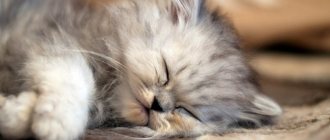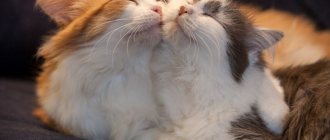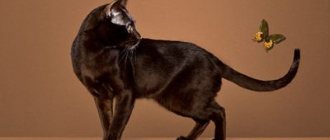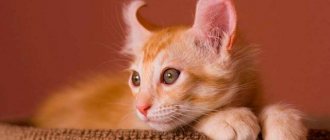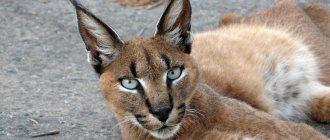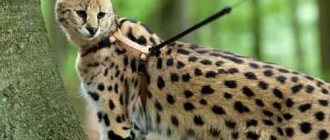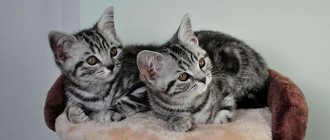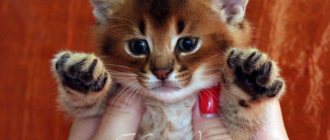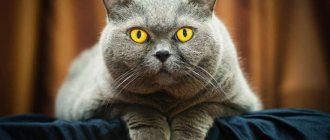There is an opinion that the steppe cat is one of the very first representatives of cats. It is believed that they existed on Earth long before the appearance of man.
They are the ancestors of modern pets. Once upon a time, cats were first domesticated in Ancient Egypt and became sacred there. Steppe cats are otherwise called “savages”. Visually, they resemble domestic cats, but they lead a wild lifestyle, which is why they differ from their counterparts.
Appearance
The wild steppe cat is a subspecies of the wild forest cat. Outwardly they are very similar, but there are also significant differences. They are more like ordinary domestic cats.
Features of the appearance of the steppe cat:
- The animals have a long and muscular body, the length of which can reach 80 centimeters. This is not to say that these are big cats;
- The weight of steppe cats does not exceed 6 kg;
- The animal's paws are strong and strong, of medium length;
- The tail is long and thin, can reach 25 centimeters in length;
- The cat's head is small in size, the muzzle is slightly elongated;
- This cat has large eyes;
- The animal has large ears, with tassels at the tips;
- The animals' fur is short but thick. In winter, the fur remains the same length, which distinguishes it from the forest cat;
- The color of steppe cats is inconspicuous, usually gray or sandy.
In a word, the steppe cat is very easy to confuse with a domestic cat.
Predators of the cat family
Forest cats once moved south and settled in the steppes and semi-deserts of Africa and Asia, choosing dense bushes near water bodies. Among the low-growing vegetation, these cats themselves became smaller than their forest counterparts, and their fur acquired a yellowish tint to match the color of sand and dry grass. This is how a new species was formed - the steppe cat. Its prey is steppe rodents: gerbils, jerboas, gophers, hares, birds. Steppe cats also benefit from their proximity to people, hunting house mice near human habitation and stealing chickens. In Central Asia and Transcaucasia, on the river and sea coasts overgrown with reeds and reeds, there lives a large and strong reed cat (haus), a hunter of near-aquatic life. Even further east, in the steppes and high mountain meadows of China, lives a little-studied Chinese cat with smoky gray fur. Secretive nocturnal hunters, these cats hide in burrows during the day, and at nightfall come out to hunt for rats, moles, zokor hamsters, birds, lizards and insects. In the dark, they navigate by sounds: extremely sensitive hearing detects any movement in the grass and even underground.
Manul
The handsome Pallas cat, a small Asian steppe cat, with a yellowish-gray fluffy coat, thick short legs, and wide whiskers on a striped, flattened face, resembles a domestic Persian cat. But the resemblance is deceptive - the character of the Pallas's cat is by no means domestic. This is a ferocious beast, ready to repel any enemy. If it is impossible to escape and hide, the Pallas cat accepts the fight, lies on his back, putting out his clawed paws. Neither a wild predator, nor a hunting dog, nor a person can break through the defenses of this wild creature without receiving painful wounds and bites.
Bloody, merciless battles flare up among Pallas cats for territories; in the spring, these cats fight fiercely for females. The size of a domestic cat, the manul is so strong that, on occasion, it can cope with a young antelope, although it is not distinguished by dexterity and agility. More often his prey is small rodents and hares, which he waylaid or caught by surprise. A vicious and independent Pallas cat, caught as an adult, may not survive captivity and die. Manula kittens raised by humans even breed in captivity, but neither they nor their descendants will become good tame pussies.
Serval
Quite large cats, servals, live in the savannas of Africa. They stay near bodies of water where water birds and rodents hide in the tall coastal grass. Serval is the longest-legged cat. Her high legs lift her above the grass, allowing her to see living creatures from above between the stems. Large ears not only catch the slightest rustle in the grass, but also save from the heat. Passing through the ears, the blood cools in the wind and returns to the body cooled, lowering its overall temperature.
Caracal
The slender steppe cat caracal has dark tufts on its ears that give it a resemblance to lynxes. But the caracal is more graceful, and its fur is short, sandy, uniform in color. Often found in the steppes, foothills and deserts of Arabia, Central Asia and India, as well as in the savannas and deserts of Africa, the caracal is considered a fairly prosperous species of cat. During the day, sleeping under a bush or in an empty hole, with the onset of darkness and coolness, caracals go out to hunt for steppe hares and foxes, gophers, jerboas, various birds and lizards. Caracals do not avoid people and occasionally steal chickens. Friendly and sociable, caracals are highly domesticated and, like cheetahs, were trained in the past to hunt small game.
Dune cat
In the African Sahara desert, among the dunes of the Arabian, Kazakh and Turkmen deserts, a dune cat found shelter. She has adapted to life in the desert: her yellowish coat is invisible in the sand, her paws, covered with hair even on the soles, allow her to walk on the hot sand, and her large ears cool the blood in the heat. In waterless sands, these cats can go without drinking, being satisfied with the moisture contained in the prey - the life juices of mice, jerboas, hares, snakes and lizards. During the hot day, sand cats hide in holes and hunt at night. In Asian deserts, winters are very cold and snowy, and the sand cat grows long, warm fur. In the deserts of southern Africa, the ecological niche of the sand cat is occupied by the black-footed cat. Black bright peas are scattered across the golden background of her skin, and “stockings” with a wide black stripe are put on her legs.
Habitat
African wild cat is another name for the animal. This name is closely related to its habitat. Steppe cats live in the vastness of Africa and Asia.
They can also be seen in Russia, but they are found only in the Astrakhan region in semi-desert areas.
They prefer to live near bodies of water where there are thickets and where they can hide to hunt for prey. Open areas are not suitable for the steppe cat. There they can become prey for large predators. Cats also do not like to settle in areas covered with snow because they are visible there.
What is a steppe cat?
The steppe or spotted cat is an animal from the cat family, a subspecies of wild forest cats. This is one of the most ancient pets that lived next to humans back in the 10th century BC. Today, the steppe cat is widespread in the wild and bears many similarities to the modern domestic cat. A distinctive feature of the spotted predator is its edge - the fur is densely packed, with a good undercoat. The animal has a “wild” color, which is found in experimental domesticated cats. Most often they are fawn with fuzzy dark spots covering the entire body. On the sides and head, the spots may merge, forming stripes; the chest and neck are noticeably lighter, they have a grayish-white tint. The general coat color can be light yellow or sandy, almost brown.
On the body of the steppe cat there are numerous fuzzy spots merging into stripes on the head, paws and tail
The size of the steppe cat is not too large, the length of its body varies from 50 to 75 centimeters with a maximum weight of 6 kilograms. The ancient cat has developed muscles, massive paws and a hunting posture; the animal is very graceful, a predator is felt in its every movement. Its tail is slightly longer than that of a domestic cat, it is thin and can reach almost 40 centimeters. The tail has a beautiful pattern consisting of black rings. The ears and eyes are small in size, the color of the iris is yellow-green, the pupils are the same as those of a domestic cat - vertical, slit-like. The pads of the paws are not covered with hair, the movements of the steppe cat are graceful, he follows the trail, placing his paw very carefully.
Lifestyle
The steppe cat is a predator just like a domestic cat. African cats have their own wild characteristics. They prefer to live along the banks of reservoirs and are not at all afraid of water, they can even swim across the river.
But snow is a problem for the African predator; they do not like to hunt on snow cover. Predators also lead a solitary cat-like lifestyle, excluding mating seasons.
Predators spend most of their time in shelters; they can occupy the burrows of foxes, porcupines and other animals, or hide in thickets of bushes.
When encountering a dangerous predator, the cat raises its tail and arches its back, its fur begins to stick out on end. If the enemy continues to attack, she lies on her back and begins to fight him off with all four paws, releasing sharp claws. At the first opportunity, he prefers to run away and hide in a shelter.
The animal's meal is usually small rodents or birds; the predator is not able to hunt larger prey than a hare.
Fur for acclimatization and camouflage
The Pallas's cat has the longest and thickest fur of all cats. Its fur is almost twice as long on its belly and tail as on the top of its head and sides. The length and thickness of the fur also varies depending on the season, becoming longer and heavier in winter to protect the animal from the snow when chasing prey. The fur helps Pallas' cats stay warm when winter temperatures drop to -50°C. In summer they can tolerate temperatures of around 38°C, seeking refuge in burrows or crevices.
The steppe cat changes color twice. In winter its coat is grayer and more uniform in color, while in summer it has buffy fur with more stripes. Since the environment around the Pallas's cat does not have many shelters, this change of colors helps it blend into the landscape.
A characteristic feature of Pallas cats is the nictitating membrane above the eye or third eyelid. It helps them protect themselves from the cold and often dusty winds of the environment. And their small, tightly set ears help them hide.
Wild cat nutrition
The African wild cat prefers to hunt animals such as small rodents, birds, and hares. The diet may also include insects and lizards. The most common rodents eaten are mice, gophers and jerboas.
Among the birds, pheasants and sparrows are distinguished, and they also prefer to hunt domestic chickens. Cats are excellent at climbing trees thanks to their long and sharp claws, climbing into bird nests and happily eating their eggs.
They can eat amphibians, and in water cartilaginous fish become food for the African cat.
These cats were named after Peter Pallas
Peter Pallas, an eighteenth-century German zoologist, first classified the Pallas cat as "Felis manul" in 1776. The word "manul" has Turkic roots. Its current scientific name "Otocolobus" is Greek for "ugly". When Pallas first described the Pallas cat, he mistakenly assumed that it was the ancestor of the Persian domestic cat due to its long coat, dense build, and flat face.
Photo: Julie Larsen Maher
Steppe cats in captivity
It is not difficult to meet a wild animal in a zoo. It should be noted that their life expectancy is low; they rarely live more than 6 years. In zoos, African cats live much longer.
It is believed that the steppe cat is an animal that has no place among people. However, if you start accustoming him to social life from infancy, then it is quite possible to raise an obedient cat.
Steppe cats are wild predators that live in semi-desert areas, often near bodies of water, where there are many thickets and other opportunities for shelter. They feed mainly on small rodents, birds and their eggs.
The most dangerous enemy of an animal is a wild dog. The life expectancy of a steppe cat in the wild is short - about 6 years. You can meet African cats at the zoo and even have a kitten at home.
History of the discovery of the species
It is assumed that the steppe cat lived 130 thousand years ago. Communication with humans began with the period of settled agriculture. Ancient people formed permanent settlements. Cats were very useful for saving crops from small rodents. From that time, more than 10,000 years ago, their domestication began.
What does a steppe cat look like?
Appearance, description
In appearance, the animal is no different from domestic cats. They also have larger males than females. Weight ranges from 3.5 to 6.5 kg, and body length from half a meter to 0.75 m. Tails, as a rule, are thin and long, reaching up to 35 cm.
Color may vary. There are spotted ones, for example, black spots on a straw background. Markings may merge into stripes. The main background of the coat can be darker: from beige to dull brown. Under the neck and on the belly the fur is lighter. The coat is dense with a thick undercoat. There is no hair on the fingertips. Small triangular ears have smooth outlines. The color of the iris ranges from marsh to green.
For your information! Regardless of the color of the animal, its tail is striated.
They have a very short mating season
Photo: www.birdingbeijing.com
Female Pallas' cat estrus lasts from 26 to 42 hours, which is shorter than most cats. The gestation period is on average 9-10 weeks. Around April-May, females give birth to two to six kittens, although some litters have been recorded as having up to eight kittens.
Kittens usually remain in their den until they are two months old, after which they “molt” and grow their adult fur. By four months, young Pallas' cats begin to hunt with their mother, and by six months they reach full size. They become sexually mature at 10-11 months.
The population is declining
Despite their widespread distribution, the number of Pallas' cats is very small. According to the IUCN Red List, the total population of Pallas's cats is 15,315 adults. Today, the species' population is declining and it is classified as critically endangered.
Photo: www.japari-library.com
Habitat loss due to overgrazing and government-sponsored pika control programs threatens pika populations. The prairie cat is also hunted for its luxurious fur and fat, the latter of which is used in some Eastern medicines to treat frostbite.

